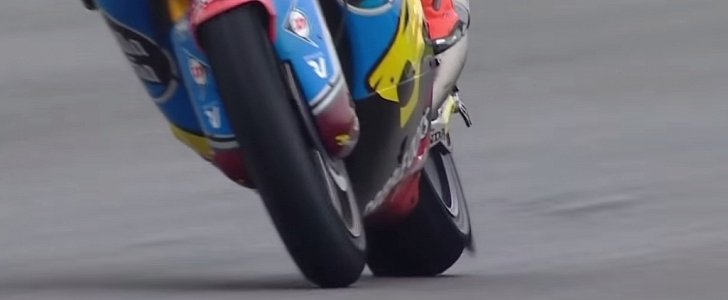The British GP that took place the past weekend was dominated by the changing atmospheric conditions and rain played a very important role in the proceedings. The short video after the jump shows why choosing the right tires for a specific race is crucial, so we hope you will enjoy it as much as we did.
The MotoGP race was declared a dry race at first, but chaos ensued as drizzle started minutes before the intended start of the race. All the riders went through pit lane to change for the wet-prepared bikes, and technically, everyone should have started from pitlane.
However, having 25 riders in the narrow tarmac section at the pit lane exit was deemed to be too dangerous, and the pack went for more sighting laps before lining up on the grid.
The Moto2 race was even more dramatic, as it begun as a wet race and ended up with a drying track. Now, mixing the wrong tires with the wrong racing surface is not only bad for speed and overall performance, but is also a major safety risk.
The compound is much softer because grip in the wet is reduced. A softer type of rubber will tend to grip the tarmac better, even when wet and in lower temperatures. However, if the cooling factor disappears, things take a dramatic turn.
Heat will build up way quicker, and the rubber will begin to decompose under the punishing, abrasive action of the road. In more severe cases, pieces of rubber may start to come off as the tire destruction is accelerated by the massive centrifugal forces.
Even though heat is one of the factors that affect grip, heat in excess, in fact, reduces the bike's adherence to the track. The tire would act more like chewing gum, as the temperature grows, and it becomes increasingly malleable to the point where it can no longer support the bike safely on asphalt.
The images below are more than self-explanatory as to the degree of destruction a wet racing tire receives when used on dry or slightly damp asphalt. As you can see, the rain tread on Tito Rabat's rear tire is almost gone, and later in the video you can also observe how much rubber torn from the tires is present on the track.
Sometimes these guys are more than racers; they are some sort of modern-day heroes. Would you picture yourself doing 250 km/h (155 mph) on such tires?
However, having 25 riders in the narrow tarmac section at the pit lane exit was deemed to be too dangerous, and the pack went for more sighting laps before lining up on the grid.
The Moto2 race was even more dramatic, as it begun as a wet race and ended up with a drying track. Now, mixing the wrong tires with the wrong racing surface is not only bad for speed and overall performance, but is also a major safety risk.
Most riders will tell you that riding in the rain with slick tires created for dry asphalt is pure suicide, but they won't be too happy either, if you ask them about using wet tires on the dry tarmac.
Rain tires come with a special tread pattern that channels water away to the sides, trying to provide as much grip for the already diminutive contact patch between rubber and tarmac. At the same time, they are engineered with a special formula that benefits from the cooling effect of the water.The compound is much softer because grip in the wet is reduced. A softer type of rubber will tend to grip the tarmac better, even when wet and in lower temperatures. However, if the cooling factor disappears, things take a dramatic turn.
Heat will build up way quicker, and the rubber will begin to decompose under the punishing, abrasive action of the road. In more severe cases, pieces of rubber may start to come off as the tire destruction is accelerated by the massive centrifugal forces.
Even though heat is one of the factors that affect grip, heat in excess, in fact, reduces the bike's adherence to the track. The tire would act more like chewing gum, as the temperature grows, and it becomes increasingly malleable to the point where it can no longer support the bike safely on asphalt.
The images below are more than self-explanatory as to the degree of destruction a wet racing tire receives when used on dry or slightly damp asphalt. As you can see, the rain tread on Tito Rabat's rear tire is almost gone, and later in the video you can also observe how much rubber torn from the tires is present on the track.
Sometimes these guys are more than racers; they are some sort of modern-day heroes. Would you picture yourself doing 250 km/h (155 mph) on such tires?





